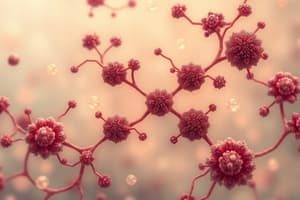Podcast
Questions and Answers
What is pharmacokinetics?
What is pharmacokinetics?
How drugs move through the body
What are the four basic principles of pharmacokinetics?
What are the four basic principles of pharmacokinetics?
Absorption, metabolism, distribution, and excretion
What is absorption and how does it occur?
What is absorption and how does it occur?
Drug enters blood through route of administration
What is distribution and what factors influence it?
What is distribution and what factors influence it?
What is metabolism and how does it affect a drug's effects?
What is metabolism and how does it affect a drug's effects?
What is elimination?
What is elimination?
How does metabolism affect a drug's effects and toxicity?
How does metabolism affect a drug's effects and toxicity?
What are the different routes of drug elimination?
What are the different routes of drug elimination?
What factors can influence the rate of drug elimination?
What factors can influence the rate of drug elimination?
Why is understanding pharmacokinetics important in drug development and clinical practice?
Why is understanding pharmacokinetics important in drug development and clinical practice?
What is inflammation?
What is inflammation?
What is fever?
What is fever?
What is an antipyretic?
What is an antipyretic?
What is an anti-inflammatory?
What is an anti-inflammatory?
What are the 5 signs of inflammation?
What are the 5 signs of inflammation?
What are the 4 types of cell mediators of inflammation?
What are the 4 types of cell mediators of inflammation?
What is acute vs chronic inflammation?
What is acute vs chronic inflammation?
What is chemotaxis?
What is chemotaxis?
What is histamine?
What is histamine?
What are homeostatic effects vs inflammatory effects?
What are homeostatic effects vs inflammatory effects?
What are the catabolic effects of steroids?
What are the catabolic effects of steroids?
Define NSAID, opioid, non-opioid, and narcotic agents.
Define NSAID, opioid, non-opioid, and narcotic agents.
Name non-pharmacological ways nurses help treat inflammation.
Name non-pharmacological ways nurses help treat inflammation.
What is COX-1 and how may blocking it harm a patient? Which organs specifically?
What is COX-1 and how may blocking it harm a patient? Which organs specifically?
What is COX-2 and how may blocking it harm a patient? Which organs specifically?
What is COX-2 and how may blocking it harm a patient? Which organs specifically?
Name 2 drugs that are COX-1 and COX-2 inhibitors.
Name 2 drugs that are COX-1 and COX-2 inhibitors.
Name 2 drugs that are COX-2 selective inhibitors.
Name 2 drugs that are COX-2 selective inhibitors.
What is adequate oxygenation?
What is adequate oxygenation?
What is adequate fluid/volume?
What is adequate fluid/volume?
What is adequate perfusion?
What is adequate perfusion?
What is the normal temperature range?
What is the normal temperature range?
What is PERRLA and what does it assess?
What is PERRLA and what does it assess?
What is the minimum oxygen saturation level needed?
What is the minimum oxygen saturation level needed?
What is respiratory rate and what is considered normal?
What is respiratory rate and what is considered normal?
What is the depth of breathing and why is it important?
What is the depth of breathing and why is it important?
What is the rhythm of breathing and what is considered normal?
What is the rhythm of breathing and what is considered normal?
What is symmetry in breathing and why is it important?
What is symmetry in breathing and why is it important?
What is effort in breathing and what is considered normal?
What is effort in breathing and what is considered normal?
Flashcards are hidden until you start studying
Study Notes
Pharmacokinetics
- Refers to how drugs move through the body.
- Four basic principles: Absorption, Distribution, Metabolism, and Excretion.
Absorption
- Involves the entry of drugs into the bloodstream via the route of administration.
Distribution
- Entails the spreading of drugs in the body.
- Influenced by blood flow to tissues and drug solubility.
Metabolism
- Biochemical process that alters drugs within the body, potentially activating or deactivating them.
Elimination
- The process of removing drugs from the body.
Metabolism Effects
- Converts drugs to active or inactive forms, which can have therapeutic or toxic effects.
Routes of Drug Elimination
- Includes renal (kidney), hepatic (liver), biliary (bile), and pulmonary (lungs) routes.
Influencing Factors for Drug Elimination
- Age, liver and kidney function, and drug interactions can affect elimination rates.
Importance of Pharmacokinetics
- Essential for predicting drug behavior, optimizing dosing regimens, and minimizing adverse effects.
Inflammation
- Body’s response to injury or infection.
Fever
- Elevation of body temperature as a part of the inflammatory response.
Antipyretic Agents
- Medications that reduce fever.
Anti-inflammatory Agents
- Reduce inflammation and alleviate associated symptoms.
Signs of Inflammation
- Characterized by redness, warmth, swelling, pain, and loss of function.
Cell Mediators of Inflammation
- Includes histamines, prostaglandins, bradykinin, and leukotrienes.
Acute vs Chronic Inflammation
- Acute: short-term response.
- Chronic: long-term, can lead to tissue damage.
Chemotaxis
- The movement of immune cells to the site of injury or infection.
Histamine
- Released during allergic reactions and inflammation; induces vasodilation.
Homeostatic vs Inflammatory Effects
- Homeostasis maintains normal physiological functions; inflammation protects against injury but can cause tissue damage if excessive.
Catabolic Effects of Steroids
- May cause muscle wasting, fat redistribution, and osteoporosis.
Definitions of Pain Relief Agents
- NSAIDs: Reduce inflammation and pain.
- Opioids: Target mu and kappa receptors for severe pain relief.
- Non-opioid analgesics: Different effects without acting on opioid receptors.
- Narcotics: Similar to opioids, induce sleep or relieve pain.
Non-pharmacological Treatments for Inflammation
- Includes ice packs, elevation, compression, and physical therapy.
COX Enzymes and Their Implications
- COX-1: Produces protective prostaglandins for the stomach; blocking may cause gastric ulcers and kidney issues.
- COX-2: Associated with inflammation; blocking can reduce pain but may increase cardiovascular risks.
COX Inhibitors
- COX-1 and COX-2 inhibitors: Ibuprofen and Aspirin.
- COX-2 selective inhibitors: Celebrex and Vioxx.
Normal Findings
- Adequate oxygenation: Successful exchange of O2 and CO2.
- Adequate fluid/volume: A balance between fluid intake and output.
- Adequate perfusion: Effective blood flow supplying oxygen and nutrients.
Normal Temperature Range
- Should be between 97.7 to 99.5 degrees Fahrenheit (36.5 to 37.5 degrees Celsius).
PERRLA
- Stands for Pupils Equal, Round, Reactive to Light and Accommodation; assesses neurological function and optic nerve.
Minimum Oxygen Saturation Level
- Should be greater than 90%.
Respiratory Rate
- Normal range is 10 to 20 breaths per minute.
Depth of Breathing
- Refers to the amount of air exchanged per breath, important for assessing pulmonary function.
Rhythm of Breathing
- The regularity and pattern of breaths; should be consistent.
Symmetry in Breathing
- Normal breathing involves bilateral chest expansion and equal air entry, indicating no respiratory issues.
Effort in Breathing
- Describes ease or difficulty in breathing; should be unlabored.
Studying That Suits You
Use AI to generate personalized quizzes and flashcards to suit your learning preferences.




